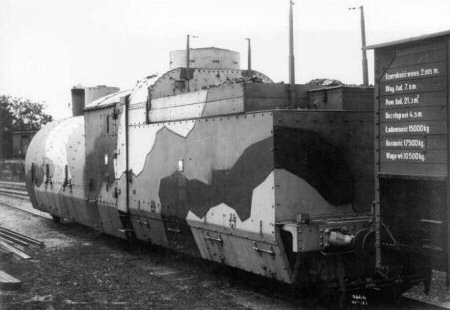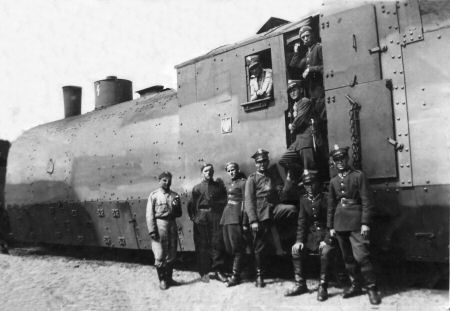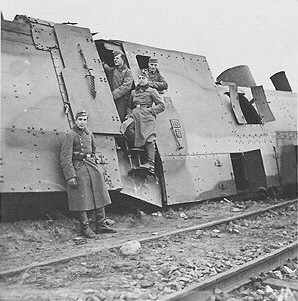Polish Ti3 armoured locomotive
Armoured locomotives of Poland: Part I - Part II - Ti3 class - Ti3-4
|
![Ti3-2 armoured locomotive [J. Magnuski]](ti3marsh.jpg) | Ti3-2 locomotive
(incorrect wheel hatches)
[J. Magnuski - 1] |
History:
In 1918-1921 period Poland used more than 100 armoured trains (not at one time), which used a variety of armoured locomotives. After the war with Soviet Russia had ended in 1921, it was decided to keep only 12 most modern armoured trains, and in the following few years most of the trains were decomposed. Then, it became possible to replace all their locomotives with only one type. As a result, in November 1926 a locomotive of the former Prussian class G53, designated as Ti3 by Polish PKP railways after 1923, armoured in Poland, was chosen as a standard locomotive for armoured trains. In following years they replaced all other types of armoured locomotives, and all Polish regular armoured trains of World War II used Ti3 locomotives. Captured Ti3 armoured locomotives were also used in several Soviet and German armoured trains during the war.
After World War I, Poland received 16 freight locomotives of Prussian series G53 (G5.3) as reparations. Just in 1918 five of them were given to the Army. At least two were armoured in 1920 in the Main Workshops of Warsaw-Praga depot (G53-4021 and G53-4024[2] - later Ti3-12 and Ti3-2). They were used at first in armoured trains "Mściciel" (Avenger) and "Generał Sosnkowski"[1]. A half-barrel armour scheme of the Ti3-2, with a space between an armour and a boiler, became a basis for later standard Ti3 armour scheme. This armour scheme, developed in Poland, based upon earlier combat experience and was rational. It certainly incorporated also some features taken from Russian armoured locomotives O class, like the commander's turret above the tender. It is not clear however, if the locomotive used in the "Mściciel" had the same armour pattern from a beginning. It might be noted, that in 1919-1920 also some locomotives of other G5 sub-series (G52 and G54) were armoured in Poland. Of these, G54 used different armour pattern, with flat sloping plates.
There were obvious advantages of armoured locomotive standardization, like easier maintenance, repairs and crew training. Less important seems simplification of armouring with standard sets of armoured plates
(given sometimes as a reason[1]), since the armour layout on particular locomotives differed much in details. Despite the G53 was not a particularly successful class, and it was made obsolete by more powerful Prussian locomotives (including G54), its performance was considered satisfactory for a purpose of armoured trains. Probably one of factors for choosing this class was its small quantity in the PKP railways, making it easier to spare, than eg. G54. On the other hand, sources do not mention, if it was a factor, but G53 class with 1'C (2-6-0) wheel arrangement offered higher maximum speed, than more powerful D (0-8-0) locomotives, like G7, G8, 73 and O classes.
On 20 November 1926 the War Ministry ordered a replacement of locomotives. The existing locomotives were to be gradually disarmoured and given to civilian service, while Ti3 were undergoing major overhaul and armouring in the Main Workshops of Warsaw-Praga depot. The standard armour design accepted in 1926 copied the already existing one, with only minor changes, like higher command compartment and a new lower observation turret of a bigger diameter. It underwent further modifications in 1930s. Both earlier armoured locomotives were upgraded to new standard as well. A whole process was slow, however, because most of twelve armoured trains were preserved in a reserve and there was no need of quick replacement. The first new Ti3 locomotives were armoured in 1927 and until 1932 all 10 were armoured and distributed by half between both Armoured Trains Units (in a meantime, in 1929 a number of armoured trains was reduced to 10, so it is doubtful, if there were created 12 armour sets, as claimed by J. Magnuski[1, 2]). It is known, that two further locomotives (Ti3-6 and Ti3-14) were given to Armoured Trains Units as unarmoured (so called "black") locomotives. The remaining four were in a civilian service in Warsaw (at Army's disposal, however)[1].
 |  |
| Ti3-3 in the first half of 1930s, with untypical four-axle tender 1D16 Nr. 201. The locomotive has old camouflage pattern and unmodified door, but has been already fitted with a radio. | The Ti3 locomotive (Ti3-5?) in late 1930s, in a standard camouflage. Note a modified two-part rearwards-opening doors, fixed in an open position. A lightning on a dome is a warning of electric traction, typical for the 1st Armoured Train Unit. |
All ten armoured locomotives series Ti3 were used in 1939 in combat in Polish regular armoured trains. There is no information, if two additional locomotives were armoured - most likely evacuation (training) armoured trains of both Armoured Trains Units in 1939 used ordinary unarmoured locomotives, not necessarily Ti3 class.
Seven armoured locomotives, in different condition, were seized with their trains in September 1939 by the Germans, and three by the Soviets. These three locomotives (nos. 2, 9 and 10) were then used in 1941 in the NKVD armoured trains, formed of the Polish stock. At least three locomotives (including one captured in the USSR - nos. 4, 9 and 13) were used in German armoured trains PZ 21, PZ 22 and PZ 10a.
Construction
Basic locomotive:
 |
| Unarmoured Ti3 locomotive of one of Armoured Trains Units. |
The freight locomotive Ti3 class, the former Prussian KPEV class G53, was a construction of Henschel und Sohns works in Kassel. They were built in 1903-1906 in six Prussian factories (BMAG, Borsig, Hanomag, Henschel, Hohenzollern, Humboldt), as a normal type 1'Cn2 Musterblatt III-3i, and a modest number of 206 were produced. The design was a development of earlier classes G51 (of 1892) and G52, while its development with compound engine was more numerous class G54. In German railways G53 were later designated as a series (Br) 546 (a short description of other G5 sub-types is here).
The Ti3 had a twin steam engine working on saturated steam, cylinder diameter was 490 mm, piston stroke 630 mm. A power output was approx. 1000 HP[1] or, according to German sources, 770 PSi. Boiler area was 137 m² (fire side), grate area was 2.29 m², boiler pressure 12 at.
Axle arrangement was 1'C (1-3-0; wheel arrangement 2-6-0 'Mogul'). A diameter of driving wheels was 1.3 m, of leading wheels - 1 m. Axle load was approximately 14.7 t. A front axle was Krauss-Helmholtz carriage.
Standard tender was three-axle, Prussian type 3T12 (Polish designation 12C1). A coal stock was 7 t (other data: 8 t) - enough for
300 km, but the water tanks had 12 m3 - enough for only 70-80 km or 3 hours of work.
One armoured locomotive (Ti3-3, in 1939 Ti3-16) was fitted with a bigger four-axle tender 1D16 (Polish designation), with 16 m³ of water (armoured in the same way).
The locomotive and tender length was 16.17 m (53 ft); height 4.2 m, with radio masts - 4.7 m.
A total weight of the armoured locomotive with tender (with coal and water) was 103 t, empty weight - 80 t, weight of an unarmoured locomotive without tender - 42,4 t.
The train's top speed was approx. 45 km/h (the locomotive's top speed forward - 65 km/h).
 |

|
Drawings of Ti3 (G5.3) locomotive [source 1] and armoured locomotive [source 2]
(note, that such form of hatches on wheels was used only in Ti3-12 in its early shape, but division lines on a boiler and tender are similar to Ti3-2. Entrance doors and command turret are late standard type) |
Armour and general arrangement:
The locomotive and the tender were fully armoured - the armour thickness was 8 - 20mm, its weight was some 13t. The armour plates were fixed with rivets or screws to the framework, leaving a space between the armour and the locomotive body (in the German service there were even made passages under armour from a driver's cab to doors cut off in the front plate, in case of Ti3-4 at least). Most likely the armour was made of thick plates of boiler steel, rather than of regular armoured plates. It gave an adequate protection against machine gun bullets and splinters, though it was not supposed to withstand direct artillery hits. It should be noted, that a locomotive boiler itself was not easy to pierce, and a spaced armour could be quite effective in this case.
The driver's cab had two big windows in sides, covered with hatches and two small round or rectangular visors in a front wall (note, that the front wall was moved forward, comparing to an unarmoured locomotive). It also had a ventilation hatch in a roof. Upon a tender there was a train's command compartment, separated from a driver's cab by a thin wall. Upper side walls of the command compartment were rounded or slanted in some locomotives, and had small windows with hatches. Above the compartment there was a cylindrical observation turret, with 8 vision slots and a hatch in a roof (turrets differed in details, mostly in construction of vision slots and hatches). The entrance to the compartment was from the driver's cab, by a ladder. Initially the armoured locomotives had one-part side doors, between the driver's cab and the tender, opening forward. Since they obscured a view from side windows, in late 1930s they were replaced with two-part doors, opening rearwards (an upper part could be opened as a window). The doors could be fixed open.
The crew of the locomotive was three, plus the commander with his assistants and radio operator. The command compartment was equipped from 1930s with a short-range radio RKB/C to contact the draisines (its aerial was stretched on four masts upon the tender) and an intercom to contact the wagons. It also had some optical and sonic means of internal communication (color lights, bells and horns).
 |
The armoured locomotive Ti3-12 (ex-G53-4021), from the "Danuta" train. It was one of the first two armoured G53 locomotives, seen here after a modernization - on a rear wall of the command compartment, a seam of joining a taller roof is visible. The locomotive has early doors, opening forward, changed afterwards. A form of four inspection hatches on wheels is typical for this locomotive only and was later changed to five taller hatches, full height of skirt. |
Variations:
Although the armour pattern and shape was generally the same, particular locomotives and tenders differed much in details, especially in division of armoured plates, a shape of a roof above the command compartment, a command turret, a way of opening of visor slots and windows, a steam dome, and inspection hatches upon wheels. There were also sometimes differences in armour division between left and right side of a locomotive. Probably there was utilised some plates stripped off of earlier armoured locomotives, especially of similar G52 series. Early armoured locomotives (Ti3-2, Ti3-3) had inspection hatches upon wheels opening upwards and fixed open with chains, while Ti3-12 had small doors there. Later they were replaced on these locomotives and new ones with single-leaf or two-leaf doors, full-height of armour skirt, but again they differed in their number and configuration. Part of locomotives, fitted with a compressor, had its two-leaf door on a right side, before the driver's cab. The locomotives of the 2nd Armoured Train Unit had flat upper surfaces of domes, while the locomotives of the 1st Unit had small sticking out hoods upon safety valves on domes. Some locomotives had a dome moved approx. 0.7 m forward on a boiler, closer to a chimney, what must have been a manufacturing factories' difference.
 |
Three locomotives of the 2nd Armoured Train Unit: Ti3-2 (the train nr. 51), Ti3-9 (the train nr. 53) and Ti3-13 (the train nr. 52) were fitted with an octagonal Ursus type turret from armoured car wz.29 instead of a common observation cupola. They also had angular, slanted upper side walls of the command compartment. The original turret was armed with a gun and two MGs in different sides, but in armoured locomotives the turrets were unarmed, with all three weapon
mountings closed with two-leaf round opening hatches. Despite some claims in publications[1], the turrets were not armed with 7.92mm wz.25 Hotchkiss anti-aircraft MG, especially, that these MGs had limited arc of fire and were dismounted from armoured cars as ineffective. It is not clear, if the turret was rotating, but there was no such need, since it had observation slots in all sides.
| On the right: Ti3-2 locomotive of the training train "Pierwszy Marszałek", in late 1930s. An assault wagon comes from the training train "Piłsudczyk". The locomotive has Ursus turret (note open hatches) and not typical additional third headlight. [collection A. Jońca] |
Camouflage:
Since about 1936, Polish armoured trains were painted in a standard three-colour camouflage for armoured vehicles, consisting of irregular grey-sand,
dark brown (sepia) and brown-green patches, with soft airbrushed transitions. A base colour was brown-green.
 |
|
Ti3-9 locomotive (the train nr.53 "Smialy"), in the latest camouflage. A flag on the front was not a common practice. [1]. |
Before 1936 an older scheme was used: the patches were probably of light yellowish sand, dark brown and dark green, separated with black stripes, with sharp, sometimes jagged edges. Lately there appeared suggestions, that at least in case of tanks, the colours were yellowish sand, olive green and light blue-gray, the latter being the lightest color (more on tankettes page). In the 1920s some other schemes were used, not researched well so far.
The locomotives of Polish armoured trains wore standard PKP (Polish State Railways, Polskie Koleje Państwowe) numbers, and "livery and lettering". All the rolling stock had plates with Polish White Eagle with red background and sometimes PKP inscription on the sides.
 |
| The captured armoured locomotive Ti3-13 (from former train nr.52 "Pilsudczyk") in German train Panzerzug 21. On the left, an assault wagon from former nr.54 ('Grozny') train, on the right an assault wagon from nr.11 ('Danuta') train (with removed aerials). It is peculiar, that this locomotive originally had Ursus type observation turret (note angular command compartment), changed by the Germans to standard cylindrical turret. The photo is taken probably in 1940-1941, because Polish machine gun cylindrical mountings has not been removed yet. This locomotive apparently has a dome closer to a chimney, than most of other locomotives Ti3 class (what is evident on drawings). The locomotive is wearing German camouflage. Note open inspection hatches on wheels. |
List of locomotives
Numbers of Polish Ti3 locomotives (the list is not a complete one):
| Polish nr.: |
Prussian
number G53- |
Armoured
train unit: |
Armoured train number: |
German number after 1939
(German armoured train): |
Manufacture year, producer,
serial number |
| Ti3-1 | LVD 303 (Latvian) | - | - | - | 1903 Hanomag /4068 |
| Ti3-2 | 4024 Danzig | 2nd | Nr. 51 "I Marszalek" | ? | 1904 Hanomag /4117 |
| Ti3-3 | 4016 Münster | 1st | Nr. 13 "Generał Sosnkowski" | - | 1904 Hanomag /4125 |
| Ti3-4 | 4023 Danzig
| 2nd | Nr. 54 "Grozny" | DRB 54 651 (PZ 22) |
1904 Hanomag /4116
|
| Ti3-5 | 4025 Danzig | 1st | Nr 15 "Smierc" | - | 1904 Hanomag /4118 |
| Ti3-6 | 4034 Essen | 1st | - not armoured? | DRB 54 652 | 1903 Hanomag /4084 |
| Ti3-7 | 4038 Essen | - | - | Ostbahn (no new number) | 1903 Humboldt /184 |
| Ti3-8 | 4114 Halle | 1st | Nr. 14 "Paderewski"? | - | 1904 Henschel /6555 |
| Ti3-9 | 4005 Katowitz | 2nd | Nr. 53 "Smialy" | ? (PZ 10b) | 1904 Borsig /5406 |
| Ti3-10 | 4015 Posen | 2nd | Nr. 55 "Bartosz Głowacki" | DRB 54 657 | 1904 BMAG /3372 |
| Ti3-11 | 4017 Posen | - | - | DRB 54 653 | 1904 BMAG /3374 |
| Ti3-12 | 4021 Münster | 1st | Nr 11 Danuta | - | 1905 Hohenzollern /1771 |
| Ti3-13 | 4022 Frankfurt | 2nd | Nr. 52 "Pilsudczyk" | DRB 54 654 (PZ 21) | 1905 Hohenzollern /1773
(or 1903, Hohenzollern/ 1775?) |
| Ti3-14 | 4052 Essen
(or: 4024 Posen?) | 2nd | - not armoured? | ? | 1904 Humboldt /228
(or: 1904 BMAG /3384 ?) |
| Ti3-15 | 4036 Stettin | - | - | - | 1904 Borsig /5413 |
| Ti3-16 | 4118 Halle | 1st | Nr 12 Poznańczyk | - | 1904 Humboldt /232 |
Sawodny's book gives German numbers 54 5021 and 54 4024 for Ti3-4 and Ti3-13 respectively, but they doesn't seem to be correct.
All corrections and additional informations or pictures are welcome!
Many thanks to Ingo Hütter for list research and Arthur Przeczek for analysis of locomotives (we look forward to see it in print).
Sources:
1. Janusz Magnuski: "Pociag pancerny 'Smialy' w trzech wojnach"; Pelta; Warsaw 1996
2. Janusz Magnuski & Steven Zaloga: "Polish armoured vehicles of WW2"; Military Modelling 9/1983
4. W. Sawodny, "Die
Panzerzüge des Deutschen Reiches"; EK Verlag
All the photos and pictures remain the property of their owners. They are published in non-commercial educational and research purpose.
[ Main page ] [ Polish armour / Polish armoured trains ]
[ Polish armoured units ] [ Steel Panthers page ] [ Links ]
You can mail
me with any questions or comments. The additional informations are welcome!

![Ti3-2 armoured locomotive [J. Magnuski]](ti3marsh.jpg)










